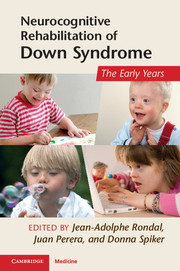Book contents
- Frontmatter
- Contents
- List of contributors
- Preface
- Acknowledgments
- Section 1 Definition, history, methodology, and assessment
- 1 Early rehabilitative intervention
- 2 The history of early intervention for infants and young children with Down syndrome and their families
- 3 Advances in clinical endpoints for neurocognitive rehabilitation in Down syndrome
- Section 2 Genetics, brain, and animal models
- Section 3 Pharmacological and medical management and treatment
- Section 4 Early development and intervention
- Section 5 Therapeutic perspectives
- Conclusions
- Index
- References
2 - The history of early intervention for infants and young children with Down syndrome and their families
Where have we been and where are we going?
Published online by Cambridge University Press: 05 July 2011
- Frontmatter
- Contents
- List of contributors
- Preface
- Acknowledgments
- Section 1 Definition, history, methodology, and assessment
- 1 Early rehabilitative intervention
- 2 The history of early intervention for infants and young children with Down syndrome and their families
- 3 Advances in clinical endpoints for neurocognitive rehabilitation in Down syndrome
- Section 2 Genetics, brain, and animal models
- Section 3 Pharmacological and medical management and treatment
- Section 4 Early development and intervention
- Section 5 Therapeutic perspectives
- Conclusions
- Index
- References
Summary
Fifty years ago, early intervention (EI) for infants and young children with Down syndrome (DS) did not exist in any formalized or universal way. Beginning with a few experimental programs instigated by the advocacy of parents and the forward thinking of researchers, the field of EI for infants and young children with disabilities was born. Since then, steady progress and significant changes have occurred in the practice of EI. Many factors are influencing what we know and how we think about EI – changes in our understanding of and research about the development of infants and young children with DS, research on early development and learning more generally, and significant policy developments and changes in expectations about participation of persons with disabilities, including those with DS, in education and the community.
This chapter presents an overview of the history of EI, with a particular emphasis on EI for infants and young children with DS. The history includes summaries of: (1) the goals of EI for both the children and their families and how they have changed over the past 50 years; (2) research on the efficacy of EI as well as its actual implementation in practice; (3) how research in early childhood and early learning has in the past and will in the future affect the practice of EI; and (4) how research and policy developments concerning older children and adults with disabilities, including those with DS, are influencing the practice of EI. Conclusions about where we have been with research and policy developments are used to discuss implications for the future directions of the EI field.
- Type
- Chapter
- Information
- Neurocognitive Rehabilitation of Down SyndromeEarly Years, pp. 15 - 35Publisher: Cambridge University PressPrint publication year: 2011
References
- 2
- Cited by



